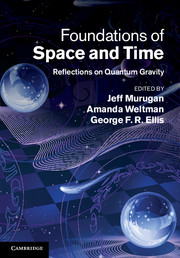Book contents
- Frontmatter
- Contents
- List of contributors
- 1 The problem with quantum gravity
- 2 A dialogue on the nature of gravity
- 3 Effective theories and modifications of gravity
- 4 The small-scale structure of spacetime
- 5 Ultraviolet divergences in supersymmetric theories
- 6 Cosmological quantum billiards
- 7 Progress in RNS string theory and pure spinors
- 8 Recent trends in superstring phenomenology
- 9 Emergent spacetime
- 10 Loop quantum gravity
- 11 Loop quantum gravity and cosmology
- 12 The microscopic dynamics of quantum space as a group field theory
- 13 Causal dynamical triangulations and the quest for quantum gravity
- 14 Proper time is stochastic time in 2D quantum gravity
- 15 Logic is to the quantum as geometry is to gravity
- 16 Causal sets: discreteness without symmetry breaking
- 17 The Big Bang, quantum gravity and black-hole information loss
- 18 Conversations in string theory
- Index
- References
15 - Logic is to the quantum as geometry is to gravity
Published online by Cambridge University Press: 05 August 2012
- Frontmatter
- Contents
- List of contributors
- 1 The problem with quantum gravity
- 2 A dialogue on the nature of gravity
- 3 Effective theories and modifications of gravity
- 4 The small-scale structure of spacetime
- 5 Ultraviolet divergences in supersymmetric theories
- 6 Cosmological quantum billiards
- 7 Progress in RNS string theory and pure spinors
- 8 Recent trends in superstring phenomenology
- 9 Emergent spacetime
- 10 Loop quantum gravity
- 11 Loop quantum gravity and cosmology
- 12 The microscopic dynamics of quantum space as a group field theory
- 13 Causal dynamical triangulations and the quest for quantum gravity
- 14 Proper time is stochastic time in 2D quantum gravity
- 15 Logic is to the quantum as geometry is to gravity
- 16 Causal sets: discreteness without symmetry breaking
- 17 The Big Bang, quantum gravity and black-hole information loss
- 18 Conversations in string theory
- Index
- References
Summary
I will propose that the reality to which the quantum formalism implicitly refers is a kind of generalized history, the word history having here the same meaning as in the phrase sum-over-histories. This proposal confers a certain independence on the concept of event, and it modifies the rules of inference concerning events in order to resolve a contradiction between the idea of reality as a single history and the principle that events of zero measure cannot happen (the Kochen-Specker paradox being a classic expression of this contradiction). The so-called measurement problem is then solved if macroscopic events satisfy classical rules of inference, and this can in principle be decided by a calculation. The resulting conception of reality involves neither multiple worlds nor external observers. It is therefore suitable for quantum gravity in general and causal sets in particular.
Quantum gravity and quantal reality
Why, in our attempts to unify our theories of gravity and the quantum, has progress been so slow? One reason, no doubt, is that it's simply a very hard problem. Another is that we lack clear guidance from experiments or astronomical observations. But I believe that a third thing holding us back is that we haven't learned how to think clearly about the quantum world in itself, without reference to “observers” and other external agents.
Because of this we don't really know how to think about the Planckian regime where quantum gravity is expected to be most relevant. We don’t know how to think about the vacuum on small scales, or about the inside of a black hole, or about the early universe. Nor do we have a way to pose questions about relativistic causality in such situations.
- Type
- Chapter
- Information
- Foundations of Space and TimeReflections on Quantum Gravity, pp. 363 - 384Publisher: Cambridge University PressPrint publication year: 2012
References
- 4
- Cited by



